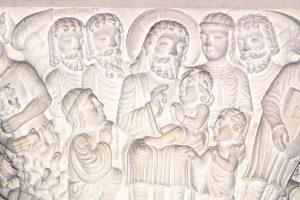These days, I find myself mindlessly crossing to the other side of the street if I see someone proceeding down the sidewalk I’m on. It’s a COVID-19 reflex I hope to kick eventually. It became engrained in us during the first two years of the pandemic that people are a danger. As a result, teachers tell me, some schoolchildren decline to take off their masks even when invited to do so. Some elders stare over their masks with frightened eyes when I approach them in the grocery aisle. Granted, some folks are ailing or have underlying conditions that give them good reason to be cautious. But in some cases—such as me crossing the street to avoid strangers—it’s just a reflexive response to a danger that may no longer be so imminent.
No surprise then that an old favorite line from 2 Corinthians that used to make me smile now incites a little anxiety: Greet one another with a holy kiss (2 Cor. 13:12). I’m still not prepared to shake hands with folks at the sign of peace: I’m certainly not prepared to pucker up!
Medical professionals acknowledge this may be wisdom. A bit of physical distance benefits public health even in non-pandemic times. Handshakes may eventually go the way of curtseys and hat tips as a means of greeting others. Curtsies and hat tips, at least, were sanitary.
But the holy kiss St. Paul encourages is meant to be more than a warm brush of the lips. In his farewell to the community at Corinth, Paul invites them to put their relationships in order, offer one another encouragement, accentuate what unifies and deemphasize divisions. Bottom line, says Paul, live in peace. That’s the holy kiss in which he is most interested: the harmony between Christians tangible in every aspect of their interactions.
It’s intriguing to note this passage is proclaimed in our assemblies on the Solemnity of the Most Holy Trinity. This is because Paul ends his letter with a rare triadic blessing: The grace of the Lord Jesus Christ, the love of God, and the communion of the Holy Spirit be with all of you. This benediction is a triad, and not dogmatically trinitarian, as Dominican scholar Jerome Murphy-O’Connor observes. The trinitarian formula is organized with God on top, Jesus in the middle, and the Spirit bringing up the rear.
Paul didn’t use the classic trinitarian formula familiar to us. As a Pharisaic Jew committed to the idea of the One God, he likely never imagined it. Paul begins and ends all his letters with benedictions that vary widely. Let’s ignore authorship questions today and consider the 13 letters traditionally assigned as Pauline. What kinds of blessings do they employ?
In nearly all the Pauline letters—plausibly written in this order: 1–2 Thessalonians, 1 Corinthians, Philippians, 2 Corinthians, Galatians, Romans, Colossians, Philemon, Ephesians, Titus, 1–2 Timothy—the initial benediction is some version of, “Grace to you and peace from God our Father and the Lord Jesus Christ.” Colossians merely offers, “Grace to you and peace from God our Father.” 1 Thessalonians offers an even more abbreviated, “Grace to you and peace,” but prior to this addresses the blessing “to the church . . . in God the Father and the Lord Jesus Christ.” Both letters to Timothy add “mercy” to the typical blessing of “grace and peace.”
The absence of the Holy Spirit in the opening Pauline benedictions may be deceptive. In 1 Thessalonians, Paul notes the Spirit’s power by Verse 5. 2 Thessalonians refers to sanctification by the Spirit in Chapter 2. 1 Corinthians mentions spiritual gifts or matters of the spirit 44 times, at least 16 of those references pertaining to the Spirit of God.
The majority of the Pauline letters introduce the reality of a powerful, sanctifying, gift-bestowing Spirit within the first chapter. Galatians delays until Chapter 3, but makes up for it in the next three chapters. In Romans, the Spirit isn’t mentioned until Chapter 5, but “the spirit of holiness” is referenced as early as Chapter 1, Verse 4. Titus highlights rebirth and renewal in the Spirit in Chapter 3, and 1 Timothy identifies the Spirit’s action in Chapter 4. Despite the absence of a Trinitarian benediction, Paul is unequivocally invested in the life of the Spirit.
But a Trinitarian sense of God in Paul’s mind is hard to presume from his writings. After all, the church didn’t formalize its understanding of the Trinity until the First Council of Constantinople in 381. As the theology of the Spirit’s role develops through the Pauline letters, it seems to lean on the ancient Israelite sense of the divine Spirit that hovers over the original waters before creation, breathes life into the first people, rallies Israel’s judges, guides the prophets, and empowers biblical kings.
This always-biblically-active Spirit was perceived as the immanent presence of God as opposed to a distant God of the mountains that many ancient peoples worshipped. In the Bible, God’s Spirit moves in the world from the first page and is always as near as the immediate need of God’s people. Paul expresses a deep reverence for the work of this Spirit. But whatever Paul’s perception was, an ever-dancing-together Trinity of three persons may not be an accurate description.
It’s from Luke and not Paul that the church’s dogmatic formulations of Trinity are largely fashioned. Luke’s second volume, Acts of the Apostles, records the sending of the Spirit at Pentecost. It describes the activity of the Spirit more than any other book, some 55 occasions. Just as God is the principal agent of the Hebrew Bible and Jesus the primary actor of the gospels, in Acts the Holy Spirit takes center stage in every vital movement of the church. The Advocate once promised by Jesus is clearly a distinct actor in the spotlight of the first generations of the church. Luke composed both his gospel and Acts a generation after the time of Paul, no doubt making use of both Paul’s evocative theology as well as Paul and Luke’s empowering personal experiences of the Spirit within the house churches.
A terrific book that presents a highly readable “history” of the Holy Spirit in Bible-study-ready format is Father George Smiga’s The Holy Spirit in the Bible (Liturgical Press), for anyone interested in exploring this topic further. All I can hope to suggest here is that, for Paul, the holy kiss of harmonic community is one essential way Paul experienced the Spirit’s presence in the churches.
Communities that were divided, contentious, and adhered to a classist sense of membership in their eucharistic celebrations did not exhibit any sign of a vitally working relationship with the Spirit. Those house churches were essentially dead. In the same way, those who claimed to belong to the school of thought of Apollos, Peter, or even Paul were similarly missing the point. The church belonged to Christ Jesus, and any other identification was grossly in error.
The holy kiss of peace that Paul urges on his communities would probably be out of sync with the present fashion of choosing which pope of the past century is the best representative of the mind of Christ. Jesus is never recorded as saying: Where two or more are gathered, with their inflexible opinions and cherished agenda, there am I in the midst of the brawl over who’s right. The path of the holy kiss is the only authentic route for the church of Jesus Christ to take. Even if some of us are not quite ready to pucker up, we might still be willing to travel this road together at a happy, healthy distance.
This article also appears in the July 2023 issue of U.S. Catholic (Vol. 88, No. 7, pages 47-49). Click here to subscribe to the magazine.
Image: Saints Peter and Paul, Jusepe de ribera, c.1612. Wikimedia Commons













Add comment